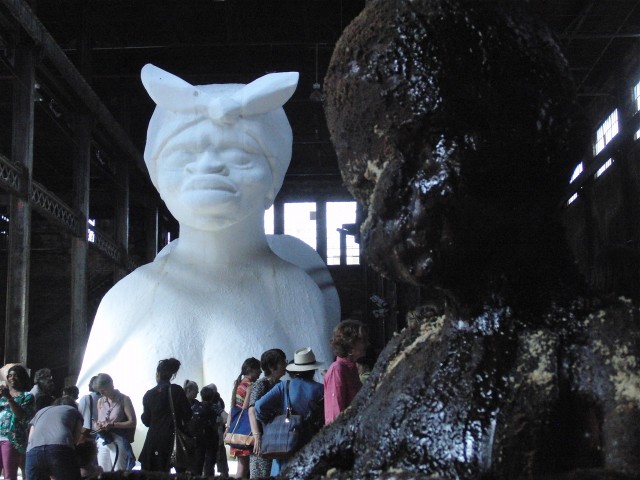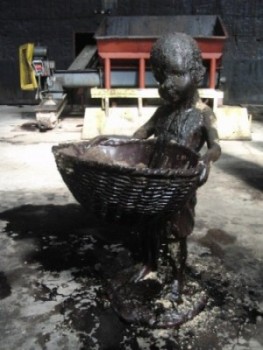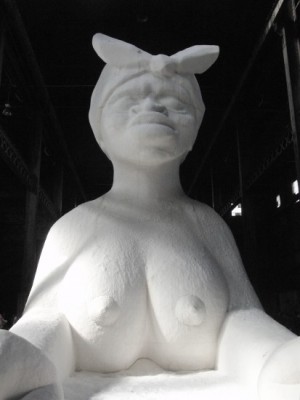
Kara Walker’s massive public art project features a sphinxlike mammy figure and life-size child slaves (photo by twi-ny/mdr)
KARA WALKER — A SUBTLETY OR THE MARVELOUS SUGAR BABY: AN HOMAGE TO THE UNPAID AND OVERWORKED ARTISANS WHO HAVE REFINED OUR SWEET TASTES FROM THE CANE FIELDS TO THE KITCHENS OF THE NEW WORLD ON THE OCCASION OF THE DEMOLITION OF THE DOMINO SUGAR REFINING PLANT
Domino Sugar Factory
South First St. at Kent Ave.
Saturday, July 5, and Sunday, July 6, free, 11:00 am – 7:00 pm
www.creativetime.org
kara walker at domino slideshow
For more than 150 years, the Domino Sugar Factory has stood tall on the Williamsburg waterfront, the first sugar refinery in Brooklyn and at one time the largest in the world. The pre-Civil War structure was rebuilt in 1882 after a fire, it closed shop in 2004, and the 30,000-square-foot location is slated for demolition in a few months, giving way to luxury housing and commercial space. But it is getting quite a send-off, temporarily home to a spectacular, multilayered public art project that will have people talking for a long time. Forty-four-year-old California-born MacArthur “Genius” Kara Walker, best known for creating black silhouettes that boldly depict the horrors of slavery (“My Complement, My Enemy, My Oppressor, My Love,” “Gone: An Historical Romance of a Civil War as It Occurred between the Dusky Thighs of One Young Negress and Her Heart”), has installed “A Subtlety or the Marvelous Sugar Baby: an Homage to the unpaid and overworked Artisans who have refined our Sweet tastes from the cane fields to the Kitchens of the New World on the Occasion of the demolition of the Domino Sugar Refining Plant,” which remains on view through July 6. Upon entering the vast, open space, visitors are greeted by more than a dozen “Sugar Babies,” life-size sculptures in resin and molasses of slave children carrying baskets or bananas; some of the figures have melted, turning into what looks like a bloody mess on the floor, as if beaten to death, while also recalling tar. The objects in the baskets are parts of their bodies that essentially dissolved and fell off, as if their true selves have been eviscerated. Meanwhile, the air is filled with an acrid, rotting smell that falls right in line with the bittersweet nature of the installation.

Melting “Sugar Babies” carry remnants of themselves in baskets at the Domino Sugar Factory (photo by twi-ny/mdr)
Glistening at the end of the large hall is an enormous white sphinx, made of foam and refined white sugar, sitting proudly, a highly sexualized mammy figure that evokes Aunt Jemima, serving as an oracle to the past, present, and future of a culture still dominated by racial tension, discrimination, and violence. A kerchief tied around her head, she stares out, her powerful fists outstretched (one in a gesture that alternately means “good luck” and “fuck you” in different countries), her large breasts both taunting and threatening. The curves of her body lead to giant buttocks and an exposed vulva that both shock and delight, laden in contradiction. The sculpture is yellowing at some points, the sugar crystalizing in the summer heat. When the exhibit ends, some of the slave babies will be able to be shown again, but the sphinx will be destroyed, erased from the annals of history, like so many aspects of slavery — but its memory will live on, a reminder of, among other things, that slavery took place right here in New York City. The controversial piece, totem and caricature, paradox and paradigm, uses stereotypes and racist imagery in referencing the refining of brown sugar into a white substance, the association of sugar with luxury desserts for the wealthy (the word “subtlety” refers to sweet banquet desserts), colonialism, and the exploitation of workers (including child labor, once again an issue on family-owned tobacco farms in America and sugar refineries in the Dominican Republic) in a society dominated by commercialism and corporations, offering an unspoken riddle with no answers. In her preliminary sketches, Walker used such phrases as “Sugar Rules the World,” “Natural processes fueled by industry,” “Production, not-consumption,” and “Refining to achieve desired whiteness which is equated in the modern mind — with purity,” lending crucial insight to her thinking. However, Walker has chosen to give no official artist’s statement about her first large-scale public art installation, preferring that people experience it for themselves, although project sponsor Creative Time has supplemented the work with five “Reports” that explore various aspects of “A Subtlety,” which can be found online: Edwidge Danticat’s “The Price of Sugar,” Tracy K. Smith’s “Photo of Sugar Cane Plantation Workers, Jamaica, 1891,” Jean-Euphèle Milcé’s “To Drink My Sweet Body,” Ricardo Cortés’s “The Act of Whitening,” and Shailja Patel’s “Unpour.”

Bittersweet Kara Walker installation is layered with meaning that is controversial, complex, and purposefully contradictory (photo by twi-ny/mdr)
Central to the work are viewers’ reactions. Some are in awe of its beauty and scope, while others pose in front of it for touristy photographs. Some consider the history and mystery that literally surround it, while others smile and pretend to put their arms around one of the slave babies as if they are friends or perform silly acts with the sphinx’s backside and genitalia. Many are so obsessed with taking pictures and video that they never pause, process, and contemplate what they are looking at. Yes, it’s spectacle, but it’s spectacle on a grand order, an unforgettable experience that places a powerful mirror on America’s four-hundred-year history, revealing telling elements that many still refuse to accept.
There are only two days left to see “A Subtlety,” which is open 11:00 am to 7:00 pm on Saturday and Sunday, July 5-6. Admission is free, but you can expect the lines to be a lot longer than the previous twenty minutes or so. After that, the piece, along with the Domino Sugar Factory itself, will meet its demise, though it will live on in the minds of those who had the opportunity to partake in its majesty.